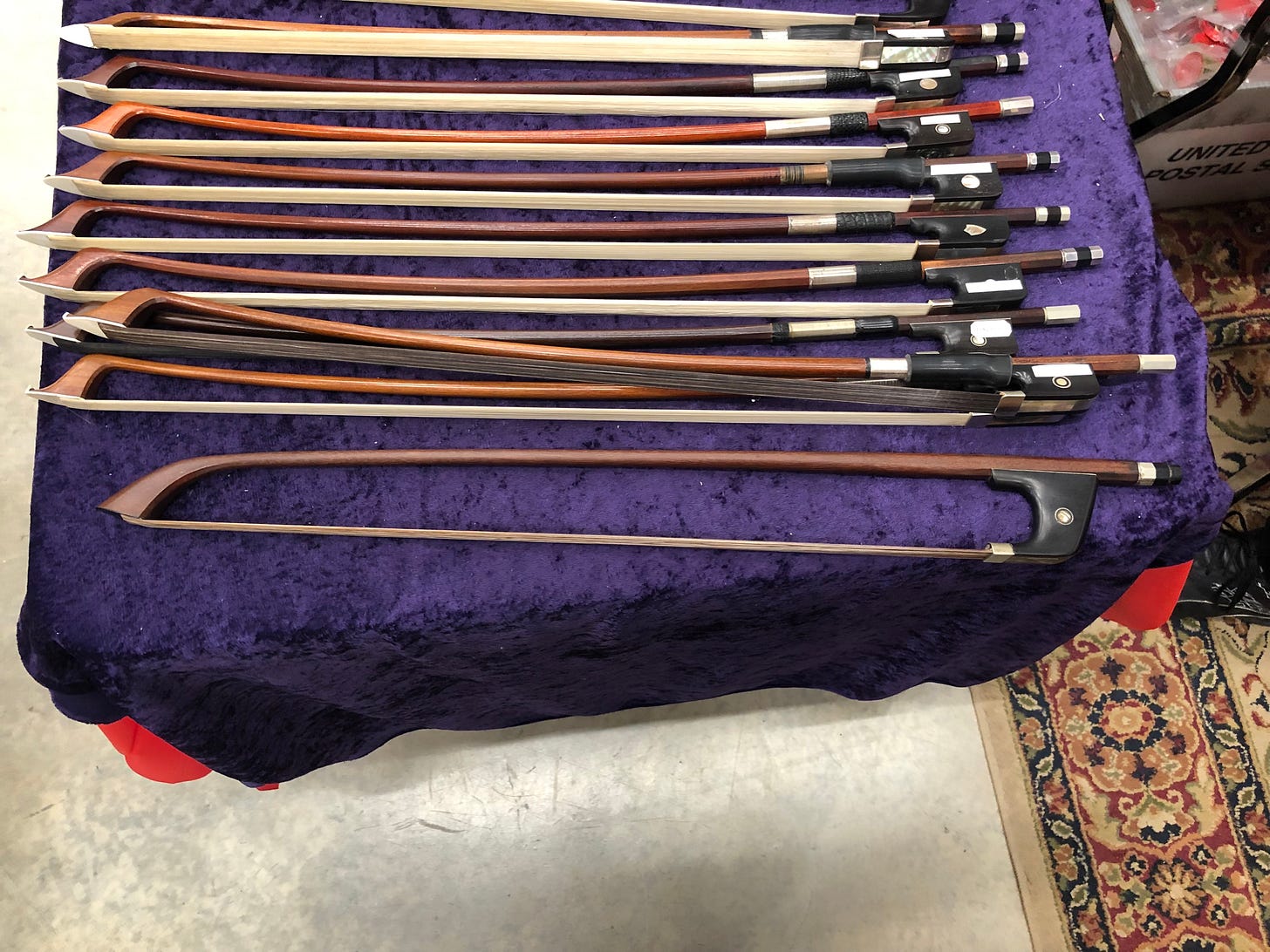Double Bass Dispatch: Get Over It!
Practical Advice for Switching from an Overhand to an Underhand Bow Hold
One unique aspect of double bass playing is that we have multiple bow hold options. While the violin, viola, and cello (our bowed-string brethren) all use an overhand bow hold, bassists can choose to hold the bow overhand (French) or underhand (German). For more information about the specifics of each bow grip, I recommend reading my 2024 article in the American String Teacher Journal.
Although bassists have a choice amongst bows, it is uncommon for someone to play both French and German bow. The bassist usually plays one or the other, and the style usually corresponds to the hold preferred by the teacher. I believe that choosing one for use in professional performance is a good idea as it creates consistency, but knowledge of how to teach both has become paramount in the 21st century. One might find that a student has physical difficulties with one of the holds, which can often be remedied by switching to the other. Furthermore, certain types of holds are often preferred in a style of playing. For example, underhand bows were much preferred to overhand bows in Baroque playing according to the available iconography. This means that the underhand style is usually more appropriate than overhand in historically-informed performance.
As someone that learned French bow during my schooling, I have found it extremely rewarding to incorporate German bow playing into both teaching and performing. Not only has the knowledge helped me better serve my students, it also opened up a whole new area of playing in the historically-informed performance (HIP) arena. These skills helped make my album 12 Waltzes for Solo Double Bass more historically accurate, as I played an underhand bow copy of Dragonetti’s that is currently housed in the Florence museum.
While I can now confidently say I bow-ambidextrous, there was a time where I knew my underhand playing was inferior. Hence if you too feel this way, you’re not alone! Here are some guidelines to help with the transition from French to German bow:
Play What You Know. This is often advice given to writers (write what you know), but the same mantra applies to bassists! You already know how a bow works: position, angle, weight, speed, tilt, etc. You may be holding the bow a different way, but the fundamental tenants of good playing are the same!
Just Hold It. The German bow grip more naturally fits the shape of the hand, so try not to over-think it! The main thing to remember is to keep your finger curdled, avoiding what I like to refer to as “pancake fingers.” (Video)
Stay Balanced. The Balance Point, or the spot where the bow won’t tilt one way or another when perched on a finger, is different on German bow. Generally speaking, it’s closer to the middle of the bow, where on French bow it’s closer to the frog. Understanding this will help with articulation.
Pull Your Weight. When playing the French bow, the weight must come from above the string. This is problematic for double bassists, as our long strings require more weight than what is used by other bowed string instrumentalists (violin, viola, cello). However, the German bow pulls the weight from behind and under the string. Not only does this allow a more voluptuous sound to be made early in the learning process, it makes it easier to play in the upper half of the bow closer to the tip.
Speed Up. It is often difficult to use a lot of bow speed while maintaining contact with the string on French bow, hence we often favor the lower half of the bow (at least I did). As mentioned in the previous bullet, keeping the weight on the string is less of an issue with German bow. Thus, be adventurous in exploring the use of bow speed as you embark on your German bow adventure.
Prestidigitation. As most string articulation in Western music was derived from violin treaties, this is one area when the overhand bow has the advantage. However, I found the best way to work through this issue with underhand bow is use the fingers to create clarity in articulation. Many of my students try to play everything with their arm and wrist, forgetting that our finger tips can create a deeper level of articulation nuance.
Pizz Adjustment. When playing pizzicato (with the fingers) on French bow, we tend to hold the frog in the palm of our hand with the tip pointing towards the ceiling. German bow is the opposite as the tip will point towards the floor, and there is not a consensus on holding the bow in the palm of our hand or with our fingers. This video from Discover Double Bass does a wonderful job exploring these options:
Low Stress Gigs. In an attempt to put some of my new skills to work, I would often force to myself to play German bow at gigs that did not require a lot of arco work. These included several pits at the Lyric Theatre of Oklahoma where I mainly need to bow long tones, and some Jazz gigs where arco playing was optional but not required. This helped boost my confidence to take my underhand playing to more orchestral gigs, and eventually to solo playing.
It may seem daunting, but I promise the journey will be worth it. Both French and German players think their way is best, but this quotation from my 2024 AST Article best illustrates my views:
Perhaps, as educators,
we should not ask ourselves “which is better,” but rather “when is it appropriate to use each one?” As advocated
by the great double bassist and pedagogue Frederick Zimmermann, I encourage “students to be versed in
both schools of the bow, an invaluable technique” (Kolstein 1981, 11–12).
Happy Practicing Everyone!



